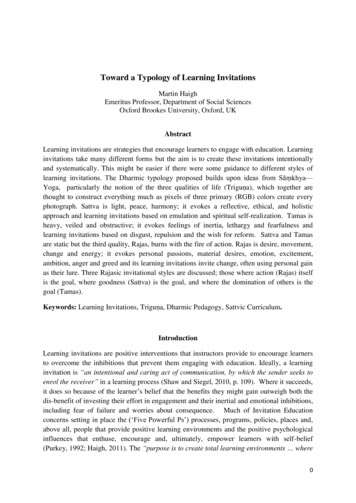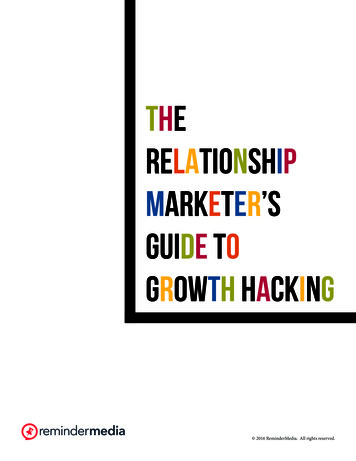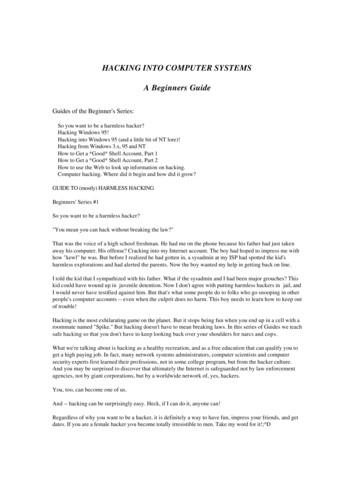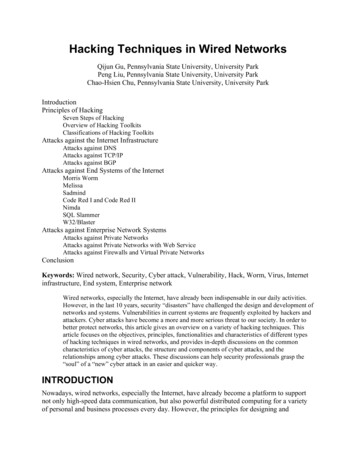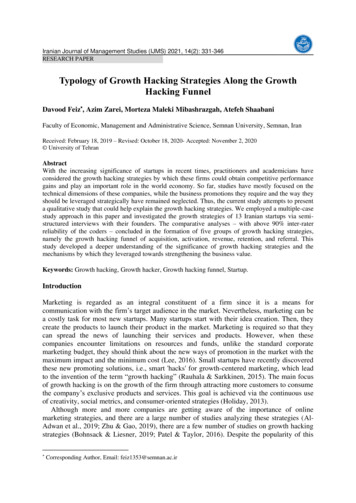
Transcription
Iranian Journal of Management Studies (IJMS) 2021, 14(2): 331-346RESEARCH PAPERTypology of Growth Hacking Strategies Along the GrowthHacking FunnelDavood Feiz , Azim Zarei, Morteza Maleki Mibashrazgah, Atefeh ShaabaniFaculty of Economic, Management and Administrative Science, Semnan University, Semnan, IranReceived: February 18, 2019 – Revised: October 18, 2020- Accepted: November 2, 2020 University of TehranAbstractWith the increasing significance of startups in recent times, practitioners and academicians haveconsidered the growth hacking strategies by which these firms could obtain competitive performancegains and play an important role in the world economy. So far, studies have mostly focused on thetechnical dimensions of these companies, while the business promotions they require and the way theyshould be leveraged strategically have remained neglected. Thus, the current study attempts to presenta qualitative study that could help explain the growth hacking strategies. We employed a multiple-casestudy approach in this paper and investigated the growth strategies of 13 Iranian startups via semistructured interviews with their founders. The comparative analyses – with above 90% inter-raterreliability of the coders – concluded in the formation of five groups of growth hacking strategies,namely the growth hacking funnel of acquisition, activation, revenue, retention, and referral. Thisstudy developed a deeper understanding of the significance of growth hacking strategies and themechanisms by which they leveraged towards strengthening the business value.Keywords: Growth hacking, Growth hacker, Growth hacking funnel, Startup.IntroductionMarketing is regarded as an integral constituent of a firm since it is a means forcommunication with the firm’s target audience in the market. Nevertheless, marketing can bea costly task for most new startups. Many startups start with their idea creation. Then, theycreate the products to launch their product in the market. Marketing is required so that theycan spread the news of launching their services and products. However, when thesecompanies encounter limitations on resources and funds, unlike the standard corporatemarketing budget, they should think about the new ways of promotion in the market with themaximum impact and the minimum cost (Lee, 2016). Small startups have recently discoveredthese new promoting solutions, i.e., smart 'hacks' for growth-centered marketing, which leadto the invention of the term “growth hacking” (Rauhala & Sarkkinen, 2015). The main focusof growth hacking is on the growth of the firm through attracting more customers to consumethe company’s exclusive products and services. This goal is achieved via the continuous useof creativity, social metrics, and consumer-oriented strategies (Holiday, 2013).Although more and more companies are getting aware of the importance of onlinemarketing strategies, and there are a large number of studies analyzing these strategies (AlAdwan et al., 2019; Zhu & Gao, 2019), there are a few number of studies on growth hackingstrategies (Bohnsack & Liesner, 2019; Patel & Taylor, 2016). Despite the popularity of this Corresponding Author, Email: feiz1353@semnan.ac.ir
332Feiz et al.term in business environments, most executives are still confused about the meaning andoperationalization of this concept. Growth hacking is yet in its early stages, and it is limited tocase studies (Dalaman, 2017; Gia, 2017; Yo Ho, 2016), best practices (Elezovic, 2017; Mai,2017), and some seminal books (Ellis & Brown, 2017; Herzberger & Jenny, 2018). Even ifcompanies have the knowledge of growth hacking, they are still confused about the method ofits usage and effect, which results in a strategy-execution gap. In order to fill this gap, one ofthe objectives of this research was to identify the growth hacking strategies. Next, a growthhacking taxonomy was developed that mapped growth hacking strategies along the growthhacking funnel leading to business value. We have more comprehensively presented thestrategies that affect the business value creation practices in startups in particular. Researchershave categorized growth hacking strategies including content marketing, relationshipmarketing, revenue making, referral marketing, and analytical strategies along growth funnel(acquisition, activation, revenue, retention, and referral). Establishing the relationshipsbetween these five groups of strategies and business value formed the main focus of thisresearch. Thus, general guidance is provided for achieving the goal, the companies are justrequired to tune these strategies to their conditions (Bohnsack, 2019).For this purpose, a multiple-case study approach was built using data from 13 Iranianstartup companies, and theoretical framework was developed. The rest of the paper isorganized as follows. The growth hacking concept is described in the next section. Then, theresearch methodology is outlined, the methods employed for data collection and sampling arepresented, and the major thematic areas we focus on in this work are defined. In the end, theresearch findings are presented and discussed, and recommendations are made for futurestudies.Growth HackingGrowth hacking is a digital marketing buzzword first coined by Sean Ellis in 2010. He was anotable marketer with affiliations to major companies such as Dropbox and LogMeIn. He wroteabout the concept of achieving efficient growth in startups that are ready to scale. Specifically,he advised startups to hire a person who is analytical, creative, and not afraid of taking risks,and whose true focus is growth (Ellis, 2010). According to Ellis, growth hacking is differentfrom marketing as it involves science, data, and process. Given that exposure attracts morecustomers, traditional marketing causes product promotion by taking advantage of the channelsof mainstream media. Meanwhile, growth hacking resorts to testing different types of strategyto develop the user base and learn about the point that which channels and methods beyond thetraditional marketing route optimally suit which products and services offered by the startup(Wilhelm, 2015). While marketing traditionally utilizes advertisement through national mediachannels, including radio, television and newspaper, growth hacking tends to discoverinnovative methods to address the target audience given the limited funds and resourcesinherent in the nature of startup (Biyani, 2013). Conventional marketing focuses on generalmarketing strategies for the entire company, while growth hacking concentrates on growth. Thekey to growth is delivering products to right customers, acquiring the user base, and identifyingproper channels to communicate with people (Lee, 2016).Research MethodA multiple-case study approach was used as the research design. This approach was selectedas we intended to observe the development of the growth hacking strategies in a real businesscontext. When multiple-case study approach is employed, the researcher is able to recognize
Iranian Journal of Management Studies (IJMS) 2021, 14(2): 331-346333and specify the technical dimensions related to the implementation and the interaction withthe business side of the company. In addition, through multiple-case studies, a replicationlogic is enabled where the cases are viewed as a series of experiments, which negate orapprove emerging conceptual insights (Battistella et al., 2017). A deductive multiple-casestudy analysis was selected in this paper, which is based on interviews with key informantsand other documents related to the companies. We selected this approach due to the need forsensitizing concepts and uncovering other aspects that were not regarded so significant in ITbusiness value studies (Gregor, 2006).The sample of our study is composed of startups with the experiences of growth hackingstrategies, regardless of the fact that they had newly initiated their work or had allocatedsignificant resources in this area. Further, our focus was on an extensive range of startupssince we could better understand the strategies through the diversity of the projects they wereinvolved in. Finally, the selected companies worked in highly dynamic and competitivemarkets; thus, they were bound to adopt growth hacking strategies to stay competitive in themarket. Hence, their endeavors for the adaption of robust growth hacking strategies wereincreased. The chosen companies had a growing position in the market with at least two yearsof working experience in Iran (Table 1).Table 1. Characteristics of artup onal postbusiness nce 33529352939292540However, the problem with this means of data collection is the subjectivity of informationas it originates from respondents. Using approaches that limit such bias, this limitation can bealleviated. In the present paper, data were collected from primary and secondary data sourcesfrom each company. The primary data source included direct interviews with the founders ofstartups. We asked about the founders’ beliefs, attitudes, and ideas about their experience withgrowth hacking strategies whose startup had tried. To avoid biased responses, we collecteddata via semi-structured interviews with the people who were directly involved in the growthhacking initiatives. Face-to-face interviews were conducted in a conversational manner. Theinterview was initiated with a discussion on the business nature, and then the interview wasfollowed according to the themes of the interview guideline. Questions were made clear by anexplanation if necessary, so that more accurate responses could be acquired. We recordedinterviews, which were transcribed for analysis. In order to authenticate the statements of therespondents, the information related to the company published on the website and onlinearticles were utilized. Totally, a semi-structured case study protocol was used for theexamination of the cases and data collection (Yin, 2013). Three authors completed theindependent coding of the transcripts according to the themes given in Table 2. The coders1. Due to the company's request, its name was not mentioned
334Feiz et al.read the transcripts individually to discover the particular strategies required for startups'growth along the growth hacking funnel. We repeated this process until the inter-raterreliability of the three coders (matched in pairs) was above 90% (Boudreau et al., 2001).MAXQDA Analytics Pro software was used for empirical analysis by an iterative processof reading, coding, and interpreting the transcribed interviews and observation notes of 13case studies (Myers & Newman, 2007). In the first phase, a large number of concepts wereidentified and separated based on the theoretical foundations. We used an open coding planfor each case for identifying the features. Thus, we could perform data clustering in a tabularstructure and determine the relative notions and concepts that could be applied for each casevia the iterative process. Overall, the extracted themes consisted of five categories of growthhacking strategies (Table 2).Table 2. The Coding SchemeCategoriesContent Marketing StrategyRelationship Marketing StrategyRevenue Making StrategyReferral Marketing StrategyAnalytical StrategyUnits of meaning/ Open CodesInformational MarketingEducational MarketingVideo MarketingSearch Engine Optimization (SEO)Social Media MarketingUser Generated ContentEmail MarketingEvent-based Content MarketingPersuasion MarketingSocial responsibility MarketingCause MarketingCooperative Marketing StrategyConversion MarketingPromotional MarketingWord of Mouth MarketingViral MarketingInfluencer MarketingData-driven, Test-driven and Scientific MarketingConversational MarketingFindingsAfter applying the already described approach to the data collected, the outcomes werevisualized as a matrix. Table 3 indicates the importance of each of the five groups ofstrategies for every company and overall rates. The larger circles ( ) represent higherimportance and greater application of that set of strategies for the startups. These circlesdemonstrate that the noted strategy was far more significant and practiced in adding thebusiness value to the related startups. Analytical and content marketing strategies were themost cited by participants, respectively. On the other hand, relationship-marketing strategieswere the least noticeable group according to the participants.Table 3. Growth Hacking Strategies Implementation in Participated Startups
Iranian Journal of Management Studies (IJMS) 2021, 14(2): 331-346335Content Marketing StrategyContent marketing refers to a strategic marketing technique that focuses on developing anddistributing valuable, pertinent, and consistent content to attract and maintain a well-definedaudience and ultimately to conduct profitable customer behavior (Pulizzi, 2012). The mostcommon content marketing formats and tactics include blog post, e-book, templates, infographics, video, podcast, guides, kits, tip sheet and checklist, webinars, white papers, casestudies, surveys/research report, user-generated content (Sobal, 2017; Kolowich, 2016;McGill, 2017) as well as magazines, printed or online newsletters, in-person roadmaps,roundtables, online interactions, emails, and events (Baltes, 2015). These content formats donot aim to spout the probity of the marketer’s own products or services; rather, they tend toinform target and prospective customers about industrial issues, sometimes encompassing themarketer’s products (Baltes, 2015). In many cases, respondents indicated that they usedifferent formats of content in order to inform and educate customers via weblogs, emails,etc. as mentioned for instance in firms 5 and 11 respectively:In the panels, educational articles are provided for users (artists) about how to pricetheir handicrafts and what they expect from a store [P5].Email is often used to introduce new services or send news and announcements aboutour business to users [P11].I try to create, educate, and introduce the freelancing system to the community bywriting articles, books, and various methods. Everything I do is to introduce this serviceto the community [P11].Content marketing was also introduced as part of digital inbound marketing (Opreana, &Vinerean, 2015) so as to organically achieve, attract, and retain consumers. All contentmarketing strategies concern another dimension of digital inbound marketing, namely searchengine optimization and special techniques that need to be executed to enhance the visibilityand accessibility of each content type (Vinrean, 2017). The importance of SEO in promotion,particularly in video marketing, was noted in firm 10:Below each video, we add new hash tags based on video subject, which could affectsearch result and optimize it [P10].The importance of uniqueness and usefulness of contents was also stated as critical factorsin SEO according to the respondent in firm 2:Because the content of our site was unique and we used our own keywords, we madegreat progress [P2].Further, content marketing is associated with social media marketing, since the developedcontent requires to be shared, propagated, and syndicated on different social platforms to helpa large audience gain access to its increased visibility. As the respondent for firm 1 said:Aparat and Filimo services are active on Telegram, Instagram, and Twitter, and newcampaigns are introduced every day. If new content is added to Filimo and we want topromote it, we will do it on our social platforms. We try to create and upload specialcontent for each of these social media sites. For example, for Aparat, we try to use themost visited and best videos that people have uploaded on Aparat, and in fact, increasethe site traffic [P1].
336Feiz et al.Primarily, companies utilized social media to share news of their products; meanwhile,social media is currently used as a two-way communication platform (Kilgour et al., 2015)and a content marketing facilitator. In this regard, our study participant number 12 stated:We have created the ability to share content on all different social and communicationnetworks. The number of social shares is small, although it is normal. The officialstatistics are that one out of every 300 visits is great. Nevertheless, our statistics are farhigher than that so it is good to rely on it in practice [P12].Other formats of content marketing such as user-generated content and event-based contentmarketing were also noted by the respondents in firms 8 and 10. They argued that it isnecessary for start-ups to be creative and spend some of their resources acquiring andmaintaining users:The information of different places of tourism or related businesses is completed by thepeople. This updated the quality of our information. It helped us a lot to be able to formour own comprehensive database so that users could help generate content, andcomplete and enrich it. This is a very positive development and can help sites,platforms, and the media [P8].We are now in the month of Ramadan. We're designing a campaign for it, and thenfootball and FIFA. Our campaigns depend a lot on the events that take place so that wecan plan [P10].Relationship Marketing StrategyIndeed, growth hacking refers to a faster creation of the right relationships as the sales andtraction foundation. Prospective buyers do not purchase and customers do not return in theabsence of strong relationships. Growth hacking refers to spotting methods for efficientlyproviding value at scale and developing engagement and trust. Growth hackers are constantlyfinding innovative ideas to create the right relationships faster (Fechter, 2017). The results ofthis qualitative study showed that growth hackers use three strategies to build the rightrelationship, including persuasion marketing, social responsibility marketing, and causemarketing.Persuasion marketing particularly applies to the promotion dimension of the marketingmix, and builds on customers’ impulsive behaviors to guide them to follow pre-plannedpathways. The persuasion science comprises strategies and approaches for applying userpsychology to develop a business. In terms of the internet commerce, persuasion marketingencompasses the design of web pages. Layout, copy, and typography as well as the rightpromotional messages are elements that incite website visitors to follow pre-plannedpathways on the website and take particular actions. Orji et al. (2015) illustrated thepersuasiveness of the six persuasive strategies including reciprocity, scarcity, authority,commitment and consistency, consensus, and liking with respect to age and gender. Verleghet al. (2015) overviewed situations in which persuasion works and does not work inadvertising. In this regard, our study participant number 1 stated:A few months ago, we changed the user panel. By working on our website, we foundout that for example if this key is moved here it can be more user friendly, this color isbetter and . so the customer does not get lost in this cycle. It's one of the fascinatingissues in our company that we can always provide the best UX, either on the site or inthe app so that we have the best feedback [P1].
Iranian Journal of Management Studies (IJMS) 2021, 14(2): 331-346337Social responsibility marketing refers to a marketing philosophy that should be consideredby a company (Armstrong & Kotler, 2008), and is based on the idea that market offeringsmust reinforce social and ethical values for the citizens’ benefit rather than being only profitdriven (Ferrell & Hartline, 2011). Many studies have recently been done on the importance ofsocial responsibility marketing in different areas. For example, Mattera and Baena (2018)conducted in-depth research on the marketing strategy of a European football club and brandmanagement strategy, and found social responsibility measures to be an effective marketingtechnique. The importance of social responsibility and the way it affects startups marketingstrategy is reflected from the respondent of firms 10, 12, and 13 respectively:A team of 30 deaf people and a number of other friends with social responsibilitymotivation began to provide subtitling for television programs such as Kolah Ghermezi,completely spontaneous and with the help of our platform [P10].The first days I started my business in a 4- or 5-meter space with a very small initialcapital. I really wanted to have a successful startup and still looking for creating jobs asa social responsibility [P12].There aren't many startups that work on eco-tourism because there is little money in it,but it is our social duty to discuss it [P13].Cause Marketing refers to a type of corporate social responsibility in which a company’spromotional campaign focuses on the dual purpose of improving society while increasingprofitability (Organ, 2017). Soni (2016) stated Cause Marketing is an established andsuccessful marketing communication technique aimed at creating a more loyal consumer baseand producing a competitive advantage. It is a good source of giving back to the communityand making a large social impact. German retail chains have begun to use Cause Marketing asan approach to distinguish their products and to ensure customer loyalty in extremelycompetitive markets (Hartmann et al., 2015). This is particularly evident in the quotation ofrespondent from firm 4:The charity support system we have put into our site raises user satisfaction. Moresatisfaction is for someone who buys, assuming that it may be a little help for a personin need [P4].Revenue Making StrategyRevenue is the fourth stage of growth hacking funnel, referring to acquiring revenue fromretained customers through developing specific values such as transiting personalizedpromotion (Yo Ho, 2016). The question is how difficult it is to make revenues from retainedcustomers. The most important issue is that startups require a lot of growth, which can beextremely costly if they do not use the right channels. Startups cannot simply apply the samemarketing strategies used by large companies owing to budget restrictions and otherlimitations (e.g., the ones associated with network). Growth hacking teams have to use theright methods to achieve better growth outcomes with a limited budget compared to thosewith proper financial background. All that matters are associated with trial and error until theright channels are identified (Salemisohi, 2015). The results of our study have showedstartups and growth hackers can use three efficient growth strategies to earn more revenue andreach better ROI, including cooperative, conversion, and different kinds of promotionalmarketing strategies.Cooperative marketing is any agreement to combine marketing efforts (advertising,promoting, or branding efforts), and thus it can appear in many forms. Resource sharing and
338Feiz et al.economies of scale are the significant reasons to cooperative marketing, especially for startupswith limited resources. Researchers have studied different kinds of cooperation in differentfirms. For instance, Yavuz and Haseki (2010) studied cooperative marketing for a Healthtourism destination in Turkey. Godfred (2018) illustrated a cooperative marketing approachand a market-driven development strategy in Sub-Saharan Africa. Abdullah and Hossain(2013) explained a new cooperative marketing strategy for agricultural products inBangladesh, and Palmer (2011) investigated the causes of the effectiveness of cooperativemarketing associations. Chom (2017) presented the cooperative model for startups. He statedthat it is a great choice for new emerging businesses to consider. Due to startups’ limitations,some respondents noted that they apply this strategy to improve their offers. For instance, therespondent for firm 4 states:We are currently planning for cooperation as cost marketing with another startup. Wewant to improve our delivery system by tracking the merchandise on the map anddecreasing the shipping time [P4].In addition, the results of analyses conducted by Cho et al. (2017) revealed thatcooperation with competitors enhances the innovation performance such as processinnovation, compared to other types of cooperation. It is also found that such cooperationprovides an opportunity for sustainable growth through field-based innovations. As put byrespondents in firm 7:Our micro books are sold on different platforms. That is, it is not just on our website,and users can find us on various platforms specialized for the book [P7].Growth hackers must focus on optimizing the conversion rate in the last step of growthhacking (Holiday, 2013). Conversion marketing involves strategies that stimulate customersto take specific actions by “converting” individuals who are browsing a website intopurchasers of products or services. Concerning online marketing, this involves not only thesales pitch but also the website design and layout as well as special actions. Conversion rateoptimization refers to the process of improving the conversion rate. The higher the conversionrates are, the more the sales, the fewer the lost customers, and the greater the return onadvertising investment will be. By converting potential customers who have alreadyexpressed at least some degree of interest, growth hackers would no longer need to attract asmany new customers to produce the same volume of sale. It is believed that proactivelyimproving products based on the insights obtained from interaction with the existingcustomers can initiate higher ROI than acquiring new users (Yo Ho, 2016). The respondent ofcompany 11 mentions the following for this strategy:Having the support widget on the front page of the site is a must. It is required for atwo-way interaction. You may need guidance as a user, and other methods do not workas efficiently [P11].Promotional marketing refers to using any special offers for raising customers’ interest andinfluencing a purchase, and to helping a particular product or company stand out among itscompetitors. Different types of online promotional marketing affect consumers’ onlineshopping behavior, including display advertisements, paid searches, emails, coupons, anddiscounts (Lio & Ji, 2018). Jiang et al. (2015) redesigned promotion strategy for e-commercecompetitiveness through pricing and recommendation. In their paper, they indicated thatthrough online price promotion (discount) and product recommendations, e-retailers couldmotivate customers to purchase the product. Chong et al. (2015) stated that variables frompromotional marketing strategies are important predictors of product demands. Lio and Ji(2018) review found that, as a primary marketing instrument, promotional marketing could
Iranian Journal of Management Studies (IJMS) 2021, 14(2): 331-346339influence consumer purchase decisions. Liu et al. (2013) estimated the sensitivity of differenttypes of online purchasers to various mainstream promotion strategies, namely discount,advertising, and word-of-mouth, and found economical purchasers to be the most sensitive todiscount promotion, direct purchasers to be the most sensitive to advertising promotion, andactive-star purchasers to be the most sensitive to the word-of-mouth promotion. Promotionalmarketing was credited as being one of the most important strategies for all firmsparticipating in this study. As put by respondents in firm 1 and 9 respectively:Filimo is the first VOD service to be launched in Iran. Through campaigns andadvertisements on sister websites such as Aparat and Sabavision, street billboards and50% discount campaigns, or competitions and lotteries that were held, it was able toattract users [P1].One of the reasons we were able to attract the audience was our free service foremployers. Although a year has passed since the start of our activity, employers can stilladvertise on our website once a week freely [P9].Referral Marketing StrategyReferral marketing strategy, also known as ambassador, Tell-A-Friend, or Refer-A-Friendprogram, refers to a powerful growth hacking approach in the growth hacking funnel. Thephilosophy behind it is to provide existing customers with methods to produce leads bythemselves and to attract more customers through word of mouth using their social area, inturn enhancing customer acquisition. Referral programs are mostly administered by offeringincentives to both existing customers (referrers) and latent customers (referees) in the form ofcredit, cash, or discount (Patel & Taylor, 2016).Referral program is among the most sustainable and cost-effective ways to grow abusiness. This program has been very successful in gaining a rapid growth for startups, likeDropbox and Airbnb. According to the founder of Dropbox, Houston, the referrals drove 60%increase in the signups (Veerasamy, 2015). Houston (2011) stated the referral programworked by encouraging customers to try something new, which they initially thought was notneeded, and then surprising them with a great product performance that turn them into happycustomers who tend to share their experiences and feelings with their own friends. This formsa viral loop or cycle that leads to exponential growth. Some respondents cited that asignificant portion of their customers is driven by the referred system. For instance, therespondent for firm 3 states:20 to 50% of our commission is paid to referrers. At first, we encourage the users torefer our platform to someone else, but after they receive the significant amount ofcommission, they are likely to want to introduce it to others so they can reap thebenefits [P3].Online word of mouth appears to be strongly effect
Growth hacking is yet in its early stages, and it is limited to case studies (Dalaman, 2017; Gia, 2017; Yo Ho, 2016), best practices (Elezovic, 2017; Mai, 2017), and some seminal books (Ellis & Brown, 2017; Herzberger & Jenny, 2018). Even if companies have the knowledge of growth hacking, they are still confused about the method of

